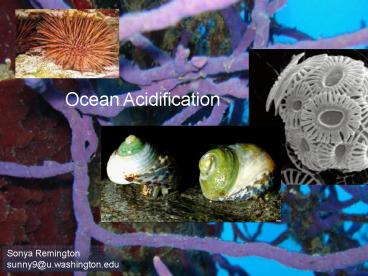Ocean Acidification - PowerPoint PPT Presentation
1 / 40
Title:
Ocean Acidification
Description:
Ocean Acidification. Sonya Remington. sunny9_at_u.washington.edu. Today's Talk on Ocean Acidification ... The Science: Understand why ocean acidification spells ... – PowerPoint PPT presentation
Number of Views:653
Avg rating:3.0/5.0
Title: Ocean Acidification
1
Ocean Acidification
Sonya Remington sunny9_at_u.washington.edu
2
Todays Talk on Ocean Acidification
The Consequences What does ocean acidification
mean for natural ecosystems and humans? The
Science Understand why ocean acidification
spells trouble for shell-building organisms.
The Solutions What can we do about this problem?
3
How big is the ocean carbon pool relative to
land and atmosphere?
- Much smaller.
- About the same.
- Much bigger.
4
According to the May 2008 Seattle Times article,
ocean acidification is not confined to the deep
ocean due to
- Increased alkalinity
- Natural upwelling
- Colder waters
- Dead plankton
5
Organisms that building their shells from calcium
carbonate are negatively impacted by ocean
acidification due to a decrease in
- Methane dissolution
- Nitrogen and phosphorous
- Carbonate ions
- General happiness
6
The Consequences
The shells of marine organisms will dissolve.
7
Loss of marine biodiversity
Coral reefs harbor more than 25 of the oceans
biodiversity provide a refuge and feeding
ground for countless marine organisms. 50
of all corals reefs are in cold, deep waters
more impacted by ocean acidification
8
Loss of food sources (fish, shellfish, etc) for
subsistence food gathering
9
Loss of sources of income for local communities,
often in developing countries
Fishing
Ecotourism
10
Decrease in biological pump Removes CO2 from
the atmosphere.
Phytoplankton - Forams
11
The Science
Why ocean acidification is occurring Why it
harms marine organisms
12
Why is Ocean Acidification Occurring?
1 Gt 109 metric tons 1015 grams 1 Gt 40,000
aircraft carriers
13
Spatial Distribution of Ocean Acidification
14
What makes ocean waters corrosive to
shell-building organisms?
Acidification or Increased Corrosiveness is due
to a Decrease in pH.
What is pH? pH a
measurement scale used to quantify
the concentration of hydrogen ions (H)
15
What makes ocean waters corrosive to
shell-building organisms?
When CO2 gas from the atmosphere dissolves in
water, H concentration increases.
16
Why does a decrease in CO32- ions spell trouble
for organisms ?
Shell-building organisms need CO32- ions for
their CaCO3 shells
Ca2 CO32- CaCO3
Shell dissolution Sea water wants more
carbonate, so it takes it from the shells
of organisms.
17
Why CaCO3 shells dissolve in seawater
Analogy Table salt (NaCl) dissolves when you
add it to a glass of tap water.
Salt dissolves
NaCl Na Cl-
(CaCO3 Ca2 CO32-)
18
Back to the ocean Why do CaCO3 shells dissolve
in seawater?
Shells are made of CaCO3
Ca2 CO32-
Shells are made of CaCO3
Ca2 CO32-
H CO32-
- The pressure generated by CO2 gas dissolved in
the water causes the CaCO3 shells - to explode.
- b. The decrease in the pH of ocean water due to
the input of atmospheric CO2 results in - and ocean that is saturated in CO32-.
- The ocean is made more acidic when CO2 from the
atmosphere results in an increase - in the H ion concentration and an
under-saturation of CO32- in the ocean.
19
Why do CaCO3 shells dissolve in seawater?
- Pressure generated by CO2
- Decreased pH leads to CO32- saturation
- Increase in H and undersatur-ation of CO32-
20
(No Transcript)
21
All CaCO3 shells are not created equal
22
The Solutions
What can we do about ocean acidification?
23
A possible geoengineering solution Add CaCO3 to
the ocean.
Reduce CO32- under-saturation caused by excess
CO2 dissolving in ocean water.
Shells are made of CaCO3
Ca2 CO32-
Shells are made of CaCO3
Ca2 CO32-
H CO32-
Sounds great, but..
24
To counteract 2 Gt C/yr input of CO2, would need
20 Gt CaCO3/yr.
White Cliffs of Dover would be rapidly
consumed. Limestone Rock (CaCO3)
Limestone mining would be expensive and would
cause ecological damage. All the energy needed
to move massive amounts of rock into the ocean
would likely add more CO2 to the atmosphere.
25
What about Fe fertilization to take care of CO2
already in the atmosphere?
Biological Pump
Phytoplankton - Forams
26
Stop adding CO2 to the atmosphere
27
Questions?
28
(No Transcript)
29
(No Transcript)
30
(No Transcript)
31
What makes ocean waters corrosive to
shell-building organisms?
Total Carbonate
32
Seattle Times article pH changed from 8.1
to 7.6 along Pacific Coast of the US Turley
February 2008 article Average pH of entire
ocean has changed by 0.1 pH units
The pH change is small Whats the big deal?
What is pH? pH a
measurement scale used to quantify
the concentration of hydrogen ions (H)
pH - log (H)
Take Home Message Small changes in pH represent
large changes in H concentration.
33
When CO2 gas from the atmosphere dissolves in
water, H concentration increases.
34
All CaCO3 is not equal Corals made of aragonite
will be more affected
Calcite (shellfish, forams) and aragonite
(corals) are both CaCO3 minerals. Same
chemical composition CaCO3
35
What can society do about Ocean Acidification?
- Stop adding CO2 to the atmosphere
- Geoengineering
- (a) Fe fertilization removes CO2 from the
atmosphere, but may have decreased - effectiveness due to damage to
phytoplankton that use - calcium carbonate to build shells
- (b) Add alkalinity to the ocean economic and
ecological costs of this would be - enormous
36
What is alkalinity?
37
Natural Upwelling How deep ocean water reaches
the surface
38
(No Transcript)
39
(No Transcript)
40
(No Transcript)































